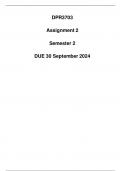DPR3703
Assignment 2
Semester 2
DUE 30 September 2024
, QUESTION 1
Evolution of Desktop Publishing
Desktop publishing (DTP) has indeed evolved significantly since its inception in the
1980s. Here is an overview of its history and the progress made over the years:
1. Origins: The term "desktop publishing" was popularized in the early 1980s when
publishers began to use personal computers equipped with graphic design software,
such as Aldus PageMaker (1985) and later Adobe InDesign (1999). Prior to this,
publishing was primarily conducted using traditional typesetting methods, which were
time-consuming and costly.
2. Early Innovations: The introduction of laser printers allowed for high -quality printing
at a fraction of the cost previously associated with professional printing services.
This democratization of publishing empowered individuals and small businesses to
create professional-quality publications.
3. Software Developments: Over the years, software for desktop publishing has
evolved, leading to enhanced functionalities including advanced typography features,
layout tools, and graphic design capabilities. Programs like QuarkXPress (1987) and
Microsoft Publisher expanded accessibility for various user levels, from novice to
professional designers.
4. Increased Accessibility: The growth of the internet and digital design tools (e.g.,
Canva, Adobe Spark) has further revolutionized desktop publishing by offering user-
friendly interfaces, templates, and cloud-based collaboration features. This has
made designing flyers, brochures, and newsletters accessible to people without
formal training in graphic design.
5. Integration with Other Media: Desktop publishing software now integrates
seamlessly with other digital media and platforms, allowing for the creation of multi-
format content including interactive PDFs, e-books, and web publications. This
cross-platform capability reflects the evolution of content consumption in a digital
age.
6. Emergence of Mobile Publishing: As mobile devices proliferate, software
applications have adapted to allow designers to create and publish optimized content
for smartphones and tablets, enhancing the readership experience across diverse
devices.
7. Examples of Evolution:
o Print and Digital Integration: Magazines and newspapers now combine
traditional print media with digital editions, allowing readers to access content
online through interactive formats.
o Crowdsourcing Designs: Websites like 99designs and Fiverr have emerged,
where individuals can post design requests, thereby crowd-sourcing
professional designs from around the world at competitive prices.





